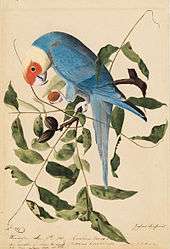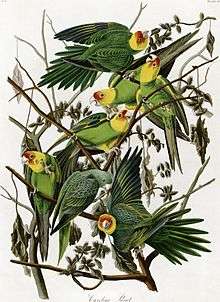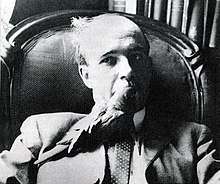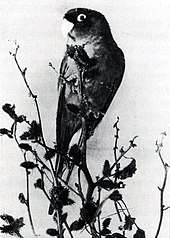Carolina parakeet
The Carolina parakeet (Conuropsis carolinensis) or Carolina conure is an extinct species of small green neotropical parrot with a bright yellow head, reddish orange face and pale beak native to the eastern, midwest and plains states of the United States. It was the only indigenous parrot within its range, as well as one of only two parrots native to the United States (the other being the thick-billed parrot). It was found from southern New York and Wisconsin to Kentucky, Tennessee and the Gulf of Mexico, from the Atlantic seaboard to as far west as eastern Colorado. It lived in old-growth forests along rivers and in swamps.[2] It was called puzzi la née ("head of yellow") or pot pot chee by the Seminole and kelinky in Chickasaw.[3] Though formerly prevalent within its range, the bird had become rare by the middle of the 19th century. The last confirmed sighting in the wild was of the ludovicianus subspecies in 1910. The last known specimen perished in captivity at the Cincinnati Zoo in 1918[4][5] and the species was declared extinct in 1939.
| Carolina parakeet | |
|---|---|
.jpg) | |
| Mounted specimen in the Field Museum | |
| Scientific classification | |
| Kingdom: | Animalia |
| Phylum: | Chordata |
| Class: | Aves |
| Order: | Psittaciformes |
| Family: | Psittacidae |
| Tribe: | Arini |
| Genus: | †Conuropsis Salvadori, 1891 |
| Species: | †C. carolinensis |
| Binomial name | |
| †Conuropsis carolinensis | |
| Subspecies | |
|
Conuropsis carolinensis carolinensis | |
| Synonyms | |
|
Psittacus carolinensis Linnaeus, 1758 | |
The earliest reference to these parrots was in 1583 in Florida reported by Sir George Peckham in A True Report of the Late Discoveries of the Newfound Lands of expeditions conducted by English explorer Sir Humphrey Gilbert who notes that explorers in North America "doe testifie that they have found in those countryes; ... parrots." They were first scientifically described in English naturalist Mark Catesby's two volume Natural History of Carolina, Florida and the Bahama Islands published in London in 1731 and 1743.
Carolina parakeets were probably poisonous—American naturalist and painter John J. Audubon noted that cats apparently died from eating them, and they are known to have eaten the toxic seeds of cockleburs.[6][7]
Taxonomy

Carolinensis is a species of the genus Conuropsis, one of numerous genera of New World Neotropical parrots in family Psittacidae of true parrots.
The specific name Psittacus carolinensis was assigned by Swedish zoologist Carl Linnaeus in the 10th edition of Systema Naturae published in 1758. The species was given its own genus Conuropsis by Italian zoologist and ornithologist Tommaso Salvadori in 1891 in his Catalogue of the Birds in the British Museum, volume 20. The name is derived from the Greek-ified conure ("parrot of the genus Conurus" an obsolete name of genus Aratinga) + -opsis ("likeness of") and Latinized Carolina (from Carolana, an English colonial province[Note 1][8]) + -ensis (of or "from a place"), therefore a bird "like a conure from Carolina".
There are two recognized subspecies. The Louisiana subspecies of the Carolina parakeet, C. c. ludovicianus,[Note 2] was slightly different in color than the nominate subspecies, being more bluish-green and generally of a somewhat subdued coloration, and became extinct in much the same way, but at a somewhat earlier date (early 1910s). The Appalachian Mountains separated these birds from the eastern C. c. carolinensis.[9]
Evolution
According to a study of mitochondrial DNA recovered from museum specimens, their closest living relatives include some of the South American Aratinga parakeets: The Nanday parakeet, the sun parakeet, and the golden-capped parakeet. The authors note the bright yellow and orange plumage and blue wing feathers found in Conuropsis carolinensis are traits shared by another species, the jandaya parakeet (A. jandaya), that was not sampled in the study but is generally thought to be closely related.[Note 3] To help resolve the divergence time a whole genome of a preserved specimen has now been sequenced.[10] Carolinensis is in a sister clade to that of Spix's macaw.[11][12] The Carolina parakeet colonized North America about 5.5 million years ago. This was well before North America and South America were joined together by the formation of the Panama land bridge about 3.5 mya. Since the Carolina parakeets' more distant relations are geographically closer to its own historic range while its closest relatives are more geographically distant to it, these data are consistent with the generally accepted hypothesis that Central and North America were colonized at different times by distinct lineages of parrots – parrots that originally invaded South America from Antarctica some time after the breakup of Gondwana, where Neotropical parrots originated approximately 50 mya.

The following cladogram shows the placement of the Carolina parakeet among its closest relatives, after a DNA study by Kirchman et al. (2012):[11]
| |||||||||||||||||||||||||||||||||||||||||||||||||
A fossil parrot, designated Conuropsis fratercula, was described based on a single humerus from the Miocene Sheep Creek Formation (possibly late Hemingfordian, c. 16 mya, possibly later) of Snake River, Nebraska.[13] This was a smaller bird, three-quarters the size of the Carolina parakeet. "The present species is of peculiar interest as it represents the first known parrot-like bird to be described as a fossil from North America." (Wetmore 1926;[13] italics added) However, it is not altogether certain that this species is correctly assigned to Conuropsis,[14] but some authors consider it a paleosubspecies of the Carolina parakeet.[Note 4]
Description
The Carolina parakeet was a small green parrot very similar in size and coloration to the extant jenday parakeet and sun conure. The majority of the plumage was green with lighter green underparts, a bright yellow head and orange forehead and face extending to behind the eyes and upper cheeks (lores). The shoulders were yellow, continuing down the outer edge of the wings. The primary feathers were mostly green, but with yellow edges on the outer primaries. Thighs were green towards the top and yellow towards the feet. Male and female adults were identical in plumage, however males were slightly larger than females (sexually dimorphic). The legs and feet were light brown. They share the zygodactyl feet of the parrot family. The skin around the eyes was white and the beak was pale flesh colored. These birds weigh about 3.5 oz.,[Note 5] are 13 in. long, and have wingspans of 21–23 in.
Young Carolina parakeets differed slightly in coloration from adults. The face and entire body was green, with paler underparts. They lacked yellow or orange plumage on the face, wings, and thighs. Hatchlings were covered in mouse-gray down, until about 39–40 days when green wings and tails appear. Fledglings had full adult plumage at around 1 year of age. ("Nature Serve, Conuropsis carolinensis", 2005; Fuller, 2001; Mauler, 2001; Rising, 2004; Snyder and Russell, 2002)
These birds were fairly long lived, at least in captivity - a pair was kept at the Cincinnati Zoo for over 35 years.
Distribution and habitat

The Carolina parakeet had the northern-most range of any known parrot. It was found from southern New England and New York and Wisconsin to Kentucky, Tennessee and the Gulf of Mexico. It has also had a wide distribution west of the Mississippi River, as far west as eastern Colorado. Its range was described by early explorers thus: the 43rd parallel as the northern limit, the 26th as the most southern, the 73rd and 106th meridians as the eastern and western boundaries respectively, the range included all or portions of at least 28 states.[Note 6] Its habitats were old-growth wetland forests along rivers and in swamps especially in the Mississippi-Missouri drainage basin with large hollow trees including cypress and sycamore to use as roosting and nesting sites.
Only very rough estimates of the birds' former prevalence can be made: with an estimated range of 20,000 to 2.5 million km2, and population density of 0.5 to 2.0 parrots per km2, population estimates range from tens of thousands to a few million birds (though the densest populations occurred in Florida covering 170,000 km2, so there may have been hundreds of thousands of the birds in that state alone).
The species may have appeared as a very rare vagrant in places as far north as Southern Ontario. A few bones, including a pygostyle found at the Calvert Site in Southern Ontario, came from the Carolina parakeet. The possibility remains open that this specimen was taken to Southern Ontario for ceremonial purposes.[15]
Behavior and diet

The bird lived in huge, noisy flocks of as many as 200–300 birds. It built its nest in a hollow tree, laying two to five (most accounts say two) 1.6 in (4.1 cm) round white eggs.
It mostly ate the seeds of forest trees and shrubs including those of cypress, hackberry, beech, sycamore, elm, pine, maple, oak, and other plants such as thistles and sandspurs (Cenchrus species). It also ate fruits, including apples, grapes and figs (often from orchards by the time of its decline).[2] It was especially noted for its predilection for cockleburs (Xanthium strumarium),[7] a plant which contains a toxic glucoside,[16] and it was considered to be an agricultural pest of grain crops.[17]
Extinction
The last captive Carolina parakeet, Incas, died at the Cincinnati Zoo on February 21, 1918, in the same cage as Martha, the last passenger pigeon, who died in 1914.[18] There are no scientific studies or surveys of this bird by American naturalists; most information about it is from anecdotal accounts and museum specimens. Therefore, details of its prevalence and decline are unverified or speculative.
There are extensive accounts of the pre-colonial and early colonial prevalence of this bird. The existence of flocks of gregarious, very colorful and raucous parrots could hardly have gone unnoted by European explorers, as parrots were virtually unknown in seafaring European nations in the 16th and 17th centuries. Later accounts in the latter half of the 19th century onward noted the birds' sparseness and absence.[19]
The birds' range collapsed from east to west with settlement and clearing of the eastern and southern deciduous forests. John J. Audubon commented as early as 1832 on the decline of the birds. The bird was rarely reported outside Florida after 1860. The last reported sighting east of the Mississippi River (except Florida) was in 1878 in Kentucky. By the turn of the century it was restricted to the swamps of central Florida. The last known wild specimen was killed in Okeechobee County, Florida, in 1904, and the last captive bird died at the Cincinnati Zoo on February 21, 1918. This was the male specimen, called "Incas", who died within a year of his mate, "Lady Jane".[20] Additional reports of the bird were made in Okeechobee County, Florida, until the late 1920s, but these are not supported by specimens. It was not until 1939, however, that the American Ornithologists' Union declared that the Carolina parakeet had become extinct. The IUCN has listed the species as extinct since 1920.
In 1937, three parakeets resembling this species were sighted and filmed in the Okefenokee Swamp of Georgia. However, the American Ornithologists' Union analyzed the film and concluded that they had probably filmed feral parakeets.[21] A year later, in 1938, a flock of parakeets was apparently sighted by a group of experienced ornithologists in the swamps of the Santee River basin in South Carolina. However, this sighting was doubted by most other ornithologists. The birds were never seen again after this sighting, and shortly after a portion of the area was destroyed to make way for power lines, making the species' continued existence unlikely.[22]
About 720 skins and 16 skeletons are housed in museums around the world[23] and analyzable DNA has been extracted from them.
Reasons for extinction
The evidence is indicative that humans had at least a contributory role in the extinction of the Carolina parakeet, through a variety of means.[24] Chief was deforestation in the 18th and 19th centuries. Hunting played a significant role, both for decorative use of their colorful feathers, for example, adornment of women's hats, and for reduction of crop predation.[1] This was partially offset by the recognition of their value in controlling invasive cockleburs. Minor roles were played by capture for the pet trade and, as noted in Pacific Standard, "One biologist has argued", by the introduction for crop pollination of European honeybees that competed for nest sites.[25]
A factor that exacerbated their decline to extinction was the flocking behavior that led them to return to the vicinity of dead and dying birds (e.g., birds downed by hunting), enabling wholesale slaughter.[26]
The final extinction of the species in the early years of the 20th century is somewhat of a mystery, as it happened so rapidly. Vigorous flocks with many juveniles and reproducing pairs were noted as late as 1896, and the birds were long-lived in captivity, but they had virtually disappeared by 1904. Sufficient nest sites remained intact, so deforestation was not the final cause. American ornithologist Noel F. Snyder[3] speculates that the most likely cause seems to be that the birds succumbed to poultry disease, although no recent or historical records exist of New World parrot populations being afflicted by domestic poultry diseases. The modern poultry scourge Newcastle disease was not detected until 1926 in Indonesia, and only a subacute form of it was reported in the United States in 1938.
See also
- Thick-billed parrot, the only living parrot that had a native range in the contiguous United States, but now restricted to Mexico
- Monk parakeet, a prevalent feral parrot in the United States often incorrectly presumed to be native
- Feral parrots, other non-native parrots in the United States
Footnotes
- a reference to the 17th century English province of Carolana, called Florida by the Spaniards and La Louisiane by the French, a grant from King Charles I which included the territory extending from the Atlantic Ocean to New Mexico, between the 30th and 36th parallels of latitude, which encompasses on the Atlantic seaboard the modern states of North and South Carolina
- ludovicianus, Latinized "of Louisiana", a reference to the Louisiana Territory of the early 19th century, which does not include the modern state of Louisiana.
- Sun parakeet, golden-capped parakeet and jenday parakeet together with sulphur-breasted parakeet are collectively referred to as the Aratinga solstitialis complex; they are so closely related that they are considered by some authorities to be subspecies of A. solstitialis.
- Molecular studies showing that carolinensis diverged from the ancestral parakeets no earlier than 5.5 mya would appear to rule out the paleosubspecies hypothesis, as well as the fossil species having a close relation to the modern carolinensis.
- There is notable conflict over the weight of this bird, with most references reporting 280 g (about 10 oz), but that would make the bird an improbable 2.5 times as heavy as the similar size closely related Nenday parakeet whose weight is given as 100–140 g (3.5–4.9 oz)
- Alabama, Arkansas, Colorado, Florida, Georgia, Illinois, Indiana, Iowa, Kansas, Kentucky, Louisiana, Maryland, Mississippi, Missouri, Nebraska, New Jersey, New York, N. Carolina, Ohio, Oklahoma, Pennsylvania, S. Carolina, S. Dakota, Tennessee, Texas, Virginia, W. Virginia, Wisconsin
References
- BirdLife International (2012). "Conuropsis carolinensis". IUCN Red List of Threatened Species. 2012. Retrieved 26 November 2013.CS1 maint: ref=harv (link)
- Griggs, Jack L. (1997). American Bird Conservancy's Field Guide to All the Birds of North America. New York: HarperPerennial. ISBN 0-06-273028-2.
- Snyder, Noel F.; Russell, Keith (2002). "Carolina Parakeet (Conuropsis carolinensis)". In Poole, A.; Gill, F. (eds.). The Birds of North America. The Birds of North America Online. 667. Philadelphia, PA: The Birds of North America, Inc. doi:10.2173/bna.667.
- Tallman, Dan A.; Swanson, David L.; Palmer, Jeffrey S. (2002). Birds of South Dakota. Midstates/Quality Quick Print. p. 181. ISBN 0-929918-06-1.
- "The last Carolina Parakeet". John James Audubon Center at Mill Grove. 22 December 2015. Retrieved 30 October 2018.
- Birkhead, Tim (2012). Bird Sense: What It's Like to Be a Bird. New York: Walker & Company. p. 123. ISBN 978-0-8027-7966-3.
- Phillips, Kristin Elise. "Plumes of Poison". Audubon Magazine. Archived from the original on 28 January 2016. Retrieved 8 August 2015.
- Coxe, Daniel (1722). A description of the English province of Carolana. London.
- Burgio, Kevin R.; Carlson, Colin J.; Tingley, Morgan W. (2017). "Lazarus ecology: Recovering the distribution and migratory patterns of the extinct Carolina parakeet". Ecology and Evolution. 7 (14): 5467–5475. doi:10.1002/ece3.3135. ISSN 2045-7758. PMC 5528215. PMID 28770082.
- Gelabert, Pere; Sandoval-Velasco, Marcela; Serres, Aitor; Manuel, Marc de; Renom, Pere; Margaryan, Ashot; Stiller, Josefin; de-Dios, Toni; Fang, Qi; Feng, Shaohong; Mañosa, Santi (6 January 2020). "Evolutionary History, Genomic Adaptation to Toxic Diet, and Extinction of the Carolina Parakeet". Current Biology. 30 (1): 108–114.e5. doi:10.1016/j.cub.2019.10.066. ISSN 0960-9822. PMID 31839456.
- Kirchman, Jeremy J.; Schirtzinger, Erin E.; Wright, Timothy F. (2012). "Phylogenetic relationships of the extinct Carolina Parakeet (Conuropsis carolinensis) inferred from DNA sequence data" (PDF). The Auk. 129 (2): 197–204. doi:10.1525/auk.2012.11259. Archived from the original (PDF) on 19 September 2012. Retrieved 22 September 2012.
- Bennu, Devorah (19 September 2012). "Extinct Carolina parakeet gives glimpse into evolution of American parrots". The Guardian. Retrieved 22 September 2012.
- Wetmore, Alexander (1926). "Descriptions of additional fossil birds from the Miocene of Nebraska" (PDF). American Museum Novitates. 211: 1–5.
- Olson, Storrs L. (1985). "The fossil record of birds. Section VIII. K. Psittaciformes". In Farner, Donald S.; King, James R.; Parkes, Kenneth C. (eds.). Avian Biology. 8. New York: Academic Press. pp. 120–121. ISBN 0-12-249408-3.
- Godfrey, W. Earl (1986). The Birds of Canada (revised ed.). National Museum of Natural History. p. 303. ISBN 0-660-10758-9.
- "Cocklebur (Xanthium strumarium L.)". University of Illinois at Champaign-Urbana: Veterinary Medicine Library. Archived from the original on 8 September 2015. Retrieved 8 August 2015.
- "Carolina Parakeet: Removal of a "Menace"". All About Birds. 15 April 2008. Retrieved 25 January 2017.
- "The last Carolina Parakeet". 22 December 2015.
- Wright, Albert (July 1912). "Early Records of the Carolina Paroquet". The Auk. 29 (3): 343–363. doi:10.2307/4071042. JSTOR 4071042.
- Snyder, Noel (June 2004). The Carolina Parakeet: Glimpses of a Vanished Bird. Princeton University Press.
- Cokinos, Christopher (2009). Hope Is the Thing with Feathers: A Personal Chronicle of Vanished Birds. Penguin. p. 41.
- McClung, Robert M. (1994). Lost Wild America: The Story of Our Extinct and Vanishing Wildlife. Linnet Books. ISBN 978-0208023599.
- Luther, Dieter (1996). Die ausgestorbenen Vögel der Welt [The extinct birds of the world] (in German) (4th ed.). Heidelberg: Westarp-Wissenschaften. ISBN 3-89432-213-6.
- "The last Carolina Parakeet". 22 December 2015.
- Cokinos, Christopher (21 February 2018). "Happy Global Last Resort Day". Pacific Standard. Retrieved 18 January 2019.
- "The last Carolina Parakeet". 22 December 2015.
Further reading
- Cokinos, Christopher (2009) Hope Is the Thing with Feathers: A Personal Chronicle of Vanished Birds (Chapter 1: Carolina Parakeet), Tarcher ISBN 978-1585427222
- Snyder, Noel (2004) The Carolina Parakeet: Glimpses of a Vanished Bird, Princeton University Press ISBN 978-0691117959
- Julian P. Hume, Michael Walters (2012) Extinct Birds (p. 186), Poyser Monographs ISBN 978-1408157251
External links
| Wikimedia Commons has media related to Conuropsis carolinensis. |
- "Songbird Foundation Birds: Extinct Species Carolina Paroquet". Archived from the original on 24 September 2010.
- Species profile - World Parrot Trust
- Fact file – ARKive
- "Carolina Parakeet (Conuropsis carolinensis) and Passenger Pigeon (Ectopistes migratorius)" - Carolina Nature
- "Carolina Parakeet: Removal of a Menace" - Cornell Lab of Ornithology
- "The Extinct Carolina Parakeet" - Ivory Bill
- News - City Parrots
